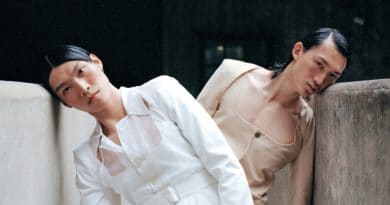How owning its manufacturing drove Buru’s profitable growth
Vertical integration doesn’t have to start with buying out an entire factory. For Los Angeles womenswear brand Buru, it can start with a single sewer.
Buru owns its own “microfactory” in Los Angeles where a team of 40 people including sewers and pattern makers assemble the brand’s small batch dresses, jackets and tops. The vertical integration allows for all sorts of benefits, including shorter production times, no delays in receiving products due to shipping problems and the chance to correct errors early, according to the brand’s founder and CEO, Morgan Hutchinson. But that team was built up slowly and without any outside funding.
“When we started the brand [a decade ago], we knew we wanted to do domestic production,” Hutchinson said. “In a lot of other countries, they have one-stop-shop manufacturers who do everything. But in the U.S., you’ve got a pattern maker here, a sample maker there. So we had to build our team ourselves.”
Hutchinson said her most important piece of advice for brands looking to vertically integrate their manufacturing is to just start, even if it’s with one person. In 2019, Buru hired a full-time sewer to do all the sewing of its goods, while the other production processes were handled internationally. The sewer used secondhand sewing machines and worked in the office alongside the rest of the company’s employees.
“It was a bit awkward at first, but we quickly realized there was a lot of value in having her in-house with us,” Hutchinson said.
In addition to sewing, Buru’s sewer could also resize mediums into smalls to help balance inventory, for example, and alter clothes that came back with errors from international manufacturers so they could still be sold.
“One of the biggest downsides of manufacturing internationally is the waiting,” Hutchinson said. “It can take so long to get your product. And if it has any errors, you have to send it back and wait longer. Fashion is so seasonal that sometimes by the time you get the product back and it’s fixed, you’ve missed your chance to sell it.”
Since then, the brand’s manufacturing team has grown to 40 people and it purchases more equipment each year. The building Buru uses as its factory is fully paid off thanks to a favorable SBA mortgage, and the brand has also used it for marketing and community-building events. Last September, to mark the brand’s 10th anniversary, Buru invited over 115 influencers and customers to tour the facility, meet the people who make the clothes and enjoy a celebratory dinner party afterward. Hutchinson also regularly visits the factory, taking pictures and sharing behind-the-scenes photos of the production process to the brand’s nearly 100,000 Instagram followers.
Buru is firmly in the advanced contemporary price range, selling dresses for $120-$300. While initially focused solely on direct-to-consumer sales, Buru established its first wholesale partnership in February with Dillard’s. Hutchinson said she’s been cautious with wholesale and is keeping the product catalog for wholesale retail separate from its DTC options.
Hutchinson described the expenses of buying the building and hiring a manufacturing team as up-front costs that paid dividends in the long run. Its small-batch product launches drive up to $150,000 in sales in a single day. Buru has become a favorite of celebrities and influencers like Brooklyn Decker and Mary Orton.
According to Hutchinson, the brand’s margins are favorable and the brand has been profitable for years. She owed that to its lack of international shipping expenses, pricey mistakes and production errors, as well as its ability to match production to demand. Later this year, Buru will open its first two retail stores, one in Charleston, South Carolina in August and the other in New York City in September.
Amid a push for more profitability, fashion companies have been keen on vertical integration and nearshoring over the last two years. Canada Goose purchased its knitwear partner Paola Confectii last year, and Golden Goose bought its biggest supplier, Italian Fashion Team, the year before that.
There’s also been a bigger push for American fashion brands to bring their manufacturing back to the U.S. The recently passed Americas Act incentivizes companies to manufacture in the Americas rather than overseas, for example. And Walmart recently partnered with apparel brand American Giant to sell a $13 T-shirt made entirely in the U.S. at scale.
“In my judgment, it begins to pose a question to the other retailers and also the presidential candidates, for that matter,” said Bayard Winthrop, founder and CEO of American Giant, on a recent episode of the Glossy Podcast. “If you can produce a really high-quality, 100% cotton, entirely made in the United States T-shirt that retails for $12.98 at Walmart, why isn’t every other brand and retailer doing that?”
The answer is partially that nearshoring is expensive and the fact that those one-stop shops that Hutchinson mentioned are plentiful in other countries. But Buru is an example of how a brand that doesn’t have Walmart’s scale or resources can start to build their own one-stop shops in the U.S., one sewer at a time.

